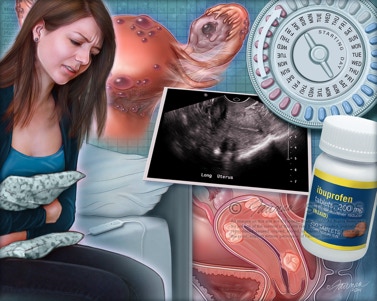

Doctors
What is dysmenorrhea?
Dysmenorrhea causes severe and frequent cramps and pain during your period. It may be either primary or secondary.
Primary dysmenorrhea. This happens when you first start your period and continues throughout your life. It is usually life-long. It can cause severe and frequent menstrual cramping due to severe and abnormal uterine contractions.
Secondary dysmenorrhea. This type is due to some physical cause. It usually starts later in life. It may be caused by another medical condition. This includes pelvic inflammatory disease or endometriosis.

Institutions
Conditions
Drugs
Insurances
TCM
Research
About Us
Contact Us
What causes dysmenorrhea?
Women with primary dysmenorrhea have abnormal contractions of the uterus due to a chemical imbalance in the body. For example, the chemical prostaglandin that controls the contractions of the uterus.
Secondary dysmenorrhea is caused by other medical conditions, most often endometriosis. This is a condition in which endometrial tissue implants outside the uterus. Endometriosis often causes internal bleeding, infection, and pelvic pain.
Other causes of secondary dysmenorrhea include the following:
Pelvic inflammatory disease (PID)
Uterine fibroids
Abnormal pregnancy (miscarriage, ectopic)
Infection, tumors, or polyps in the pelvic cavity
What are the symptoms of dysmenorrhea?
The following are the most common symptoms of dysmenorrhea. However, each person may experience symptoms differently. Symptoms may include:
Cramping in the lower belly
Pain in the lower belly
Low back pain
Pain radiating down the legs
Nausea
Vomiting
Diarrhea
Fatigue
Weakness
Fainting
Headaches
The symptoms of dysmenorrhea may look like other conditions or medical problems. Always talk your healthcare provider for a diagnosis.
What are the risk factors for dysmenorrhea?
While any woman can develop dysmenorrhea, the following women may be at an increased risk for the condition:
Women who smoke
Women who drink alcohol during their period (alcohol tends to prolong menstrual pain)
Women who are overweight
Women who started their periods before the age of 11
Women who have never been pregnant
Talk with your healthcare provider for more information.
How is dysmenorrhea diagnosed?
To diagnose dysmenorrhea, your healthcare provider will evaluate your medical history and do a complete physical and pelvic exam. Other tests may include:
Ultrasound. This test uses high-frequency sound waves to create an image of the internal organs.
Magnetic resonance imaging (MRI). This test uses large magnets, radiofrequencies, and a computer to make detailed images of organs and structures within the body.
Laparoscopy. This minor procedure uses a laparoscope. This is a thin tube with a lens and a light. It is inserted into an incision in the abdominal wall. Using the laparoscope to see into the pelvic and abdomen area, the healthcare provider can often find abnormal growths.
Hysteroscopy. This is the visual exam of the canal of the cervix and the inside of the uterus. It uses a viewing instrument (hysteroscope) inserted through the vagina.
How is dysmenorrhea treated?
Specific treatment for dysmenorrhea will be discussed with you by your healthcare provider based on:
Your age, overall health, and medical history
Extent of the condition
Cause of the condition (primary or secondary)
Your tolerance for specific medicines, procedures, or therapies
Expectations for the course of the condition
Your opinion or preference
Treatment to manage dysmenorrhea symptoms may include:
Prostaglandin inhibitors, such as nonsteroidal anti-inflammatory medicines, or NSAIDs, such as aspirin and ibuprofen (to reduce pain)
Acetaminophen
Oral contraceptives (ovulation inhibitors)
Progesterone (hormone treatment)
Diet changes (to increase protein and decrease sugar and caffeine intake)
Vitamin supplements
Regular exercise
Heating pad across the belly
Hot bath or shower
Abdominal massage
Endometrial ablation (a procedure to destroy the lining of the uterus)
Endometrial resection (a procedure to remove the lining of the uterus).
Hysterectomy ( the surgical removal of the uterus)
Key points about dysmenorrhea
Dysmenorrhea is characterized by severe and frequent menstrual cramps and pain during your period.
Dysmenorrhea may be primary, existing from the beginning of periods, or secondary, due to an underlying condition.
Symptoms may include cramping or pain in the lower abdomen, low back pain, pain spreading down the legs, nausea, vomiting, diarrhea, fatigue, weakness, fainting, or headaches.
Treatments may include NSAIDS, acetaminophen, birth control pills, hormone treatment, dietary changes, vitamins, exercise, heat, or massage.
In extreme conditions, surgery may be needed.
Next steps
Tips to help you get the most from a visit to your healthcare provider:
Know the reason for your visit and what you want to happen.
Before your visit, write down questions you want answered.
Bring someone with you to help you ask questions and remember what your provider tells you.
At the visit, write down the name of a new diagnosis, and any new medicines, treatments, or tests. Also write down any new instructions your provider gives you.
Know why a new medicine or treatment is prescribed, and how it will help you. Also know what the side effects are.
Ask if your condition can be treated in other ways.
Know why a test or procedure is recommended and what the results could mean.
Know what to expect if you do not take the medicine or have the test or procedure.
If you have a follow-up appointment, write down the date, time, and purpose for that visit.
Know how you can contact your provider if you have questions.















